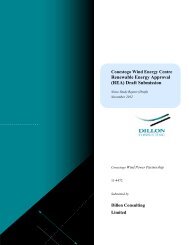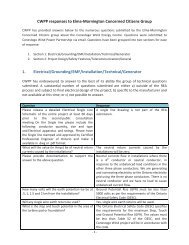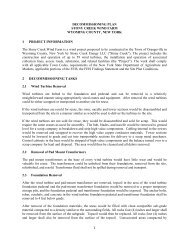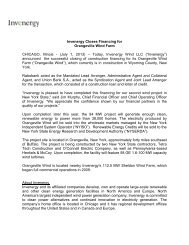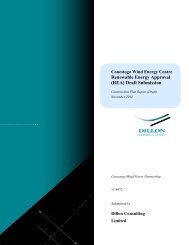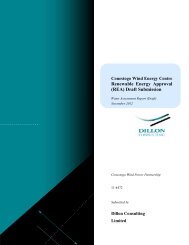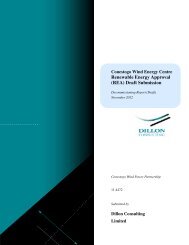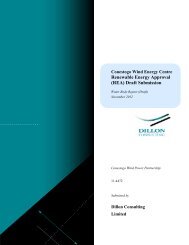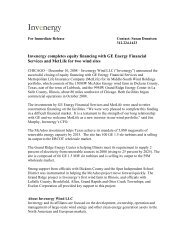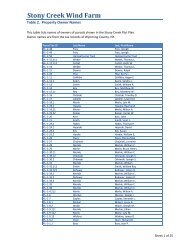Draft Records Review Report - Invenergy
Draft Records Review Report - Invenergy
Draft Records Review Report - Invenergy
You also want an ePaper? Increase the reach of your titles
YUMPU automatically turns print PDFs into web optimized ePapers that Google loves.
Conestogo Wind Power Partnership – Conestogo Wind Energy Centre<br />
Renewable Energy Approval (REA) <strong>Draft</strong> Submission<br />
Natural Heritage Assessment <strong>Records</strong> <strong>Review</strong> <strong>Report</strong> (<strong>Draft</strong>)<br />
Table 1.2.1 in the draft 6E Criterion Schedule (MNR 2012), rare vegetation communities include<br />
cliffs and talus slops, sand barrens, alvars, old growth forests, tallgrass prairies and other rare<br />
vegetation communities.<br />
6.1.6.3 Specialized Wildlife Habitat<br />
Some wildlife species require large areas of suitable habitat for their long-term survival. Many<br />
wildlife species require substantial areas of suitable habitat for successful breeding. Their<br />
populations decline when habitat becomes fragmented and reduced in size. Specialized habitat<br />
for wildlife is a community or diversity-based category, therefore, the more wildlife species a<br />
habitat contains, the more significant the habitat becomes to the planning area. The largest and<br />
least fragmented habitats within a planning area will support the most significant populations of<br />
wildlife.<br />
A search and analysis of the records and resources outlined in Table 1 did not identify any<br />
known specialized wildlife habitat in the project location or within the surrounding 120 metres.<br />
The specialized habitats for wildlife that are considered as significant wildlife habitat are<br />
outlined in Table 1.2.2 of the draft 6E Criterion Schedule (MNR 2012) and include: waterfowl<br />
nesting areas, Bald Eagle and Osprey nesting, foraging and perching habitat, woodland raptor<br />
nesting habitat, turtle nesting areas, seeps and springs, and amphibian breeding habitat (both<br />
woodland and wetland).<br />
6.1.6.4 Habitat of Species of Conservation Concern<br />
Habitats of Species of Conservation Concern include wildlife species that are listed provincially<br />
as Special Concern or rare (i.e., SRank of S1-S3). These habitats are typically associated with<br />
species in decline. Habitats of Species of Conservation Concern do not include habitats of<br />
Endangered or Threatened species as identified by the Endangered Species Act, 2007.<br />
A search and analysis of the records and resources outlined in Table 1 did not identify any<br />
specific Habitats of Species of Conservation Concern as outlined in Table 1.3 in the<br />
draft 6E Criterion Schedule (MNR 2012). These habitats include marsh bird breeding habitat,<br />
woodland area-sensitive bird breeding habitat, open country bird breeding habitat, shrub/early<br />
successional bird breeding habitat and terrestrial Crayfish habitat. However, based on<br />
background information, Dillon identified several Species of Conservation Concern as having<br />
Dillon Consulting Limited – November 2012 – 11-4472 Page 12



